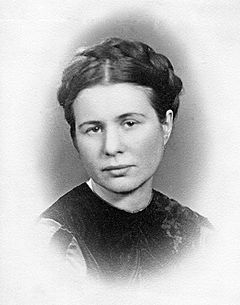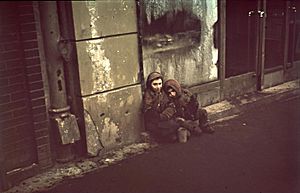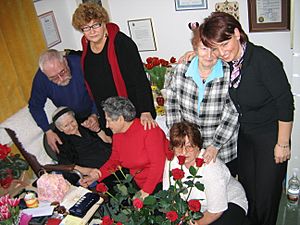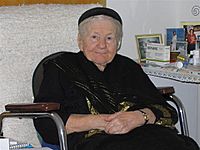Irena Sendler facts for kids
Quick facts for kids
Irena Sendler
|
|
|---|---|

Sendler c. 1942
|
|
| Born |
Irena Krzyżanowska
15 February 1910 Otwock, Poland
|
| Died | 12 May 2008 (aged 98) Warsaw, Poland
|
| Occupation | Social worker, humanitarian |
| Spouse(s) | Mieczyslaw Sendler (1931–1947; divorced) Stefan Zgrzembski (1947–1959; divorced; 3 children) Mieczyslaw Sendler (1960s; divorced) |
| Parent(s) | Stanisław Krzyżanowski Janina Krzyżanowska |
| Religion | Roman Catholic |
Irena Sendler , was a Polish nurse, humanitarian, and social worker who served in the Polish Underground during World War II in German-occupied Warsaw, and was head of the children's section of Żegota, the Polish Council to Aid Jews (Polish: Rada Pomocy Żydom), which was active from 1942 to 1945.
Assisted by some two dozen other Żegota members, Sendler smuggled approximately 2,500 Jewish children out of the Warsaw Ghetto and then provided them with false identity documents and shelter, outside the Ghetto, saving those children from the Holocaust. With the exception of diplomats who issued visas to help Jews flee Nazi-occupied Europe, Sendler saved more Jews than any other individual during the Holocaust.
The German occupiers eventually discovered her activities, and she was arrested by the Gestapo, interigated and sentenced to death, but managed to evade execution and survive the war. In 1965, Sendler was recognised by the State of Israel as Righteous among the Nations. Late in life, she was awarded the Order of the White Eagle, Poland's highest honour, for her wartime humanitarian efforts.
Biography
Sendler was born Irena Krzyżanowska on 15 February 1910 in Warsaw, to Dr. Stanisław Krzyżanowski, a physician, and his wife, Janina. She grew up in Otwock, a town about 15 miles (24 km) southeast of Warsaw, where there was a vibrant Jewish community. Her father, who was a humanitarian treating the very poor free of charge, including Jews, died in February 1917 from typhus contracted from his patients. After his death, the Jewish community leaders offered to help her mother pay for Sendler's education, though her mother declined their assistance. Sendler studied Polish literature at Warsaw University, and joined the Polish Socialist Party. She opposed the ghetto-bench system that existed at some pre-war Polish universities and defaced her grade card. As a result of this public protest, she was suspended from the University of Warsaw for three years.
World War II
Sendler moved to Warsaw prior to the outbreak of World War II, and worked for municipal Social Welfare departments. She began aiding Jews soon after the German invasion in 1939, by leading a group of co-workers who created more than 3,000 false documents to help Jewish families. This work was done at huge risk, as—since October 1941—giving any kind of assistance to Jews in German-occupied Poland was punishable by death, not just for the person who was providing the help but also for their entire family or household. Poland was the only country in German-occupied Europe in which such a death penalty was applied.
In August 1943, Sendler, by then known by her nom de guerre Jolanta, was nominated by Żegota, the underground organization also known as the Council to Aid Jews, to head its Jewish children's section. As an employee of the Social Welfare Department, she had a special permit to enter the Warsaw Ghetto to check for signs of typhus, a disease the Germans feared would spread beyond the Ghetto. During these visits, she wore a Star of David as a sign of solidarity with the Jewish people. Under the pretext of conducting inspections of sanitary conditions within the Ghetto, Sendler and her co-workers smuggled out babies and small children, sometimes in ambulances and trams, sometimes hiding them in packages and suitcases, and using various other means.
Jewish children were placed with Polish Christian families, the Warsaw orphanage of the Sisters of the Family of Mary, or Roman Catholic convents such as the Little Sister Servants of the Blessed Virgin Mary Conceived Immaculate. Sendler worked closely with a group of about 30 volunteers, mostly women, who included Zofia Kossak-Szczucka, a resistance fighter and writer, and Matylda Getter, Mother Provincial of the Franciscan Sisters of the Family of Mary. The children were given fake Christian names and taught Christian prayers in case they were tested. Sendler was determined to prevent the children from losing their Jewish identities, and kept careful documentation listing the children's fake Christian names, their given names, and their current location.
According to American historian Debórah Dwork, Sendler was "the inspiration and the prime mover for the whole network that saved those 2,500 Jewish children." About 400 of the children were directly smuggled out by Sendler herself. She and her co-workers buried lists of the hidden children in jars in order to keep track of their original and new identities. The aim was to return the children to their original families when the war was over.
In 1943, Sendler was arrested by the Gestapo. As they ransacked her house, Sendler tossed the lists of children to her friend, who hid the list in her loose clothing. Should the Gestapo access this information, all children would be compromised, but her friend was never searched, she refused to betray any of her comrades or the children they rescued, and was sentenced to death by firing squad.
Żegota saved her life by bribing the guards on the way to her execution. After her escape, she hid from the Germans, but returned to Warsaw under a fake name and continued her involvement with the Żegota. During the Warsaw Uprising, she worked as a nurse in a public hospital, where she hid five Jews. She continued to work as a nurse until the Germans left Warsaw, retreating before the advancing Soviet troops.
After the war, she and her co-workers gathered all of the children's records with the names and locations of the hidden Jewish children and gave them to their Żegota colleague Adolf Berman and his staff at the Central Committee of Polish Jews. Almost all of the children's parents had been killed at the Treblinka extermination camp or had gone missing.
Recognition and remembrance
In 1965, Sendler was recognized by as one of the Polish Righteous among the Nations and a tree was planted in her honor at the entrance to the Avenue of the Righteous. There was no further public recognition of her wartime resistance and humanitarian work until after the end of communist rule in Poland.
In 1991, Sendler was made an honorary citizen of Israel. On 12 June 1996, she was awarded the Commander's Cross of the Order of Polonia Restituta. She received a higher version of this award, the Commander's Cross with Star, on 7 November 2001.
Nevertheless, Irena Sendler's achievements remained largely unknown to the world until 1999, when students at a high school in Uniontown, Kansas, along with their teacher Norman Conard, produced a play based on their research into her life story, which they called Life in a Jar. It was a surprising success, staged over 200 times in the United States and abroad, and significantly contributed to publicising Sendler's history worldwide.
In March 2002, B’nai Jehudah Temple of Kansas City presented Sendler, Conard and the students who produced the play with its annual award “for contributions made to saving the world” (Tikkun Olam Award). The play was adapted for television as The Courageous Heart of Irena Sendler (2009), directed by John Kent Harrison, in which Sendler was portrayed by actress Anna Paquin.
In 2003, Pope John Paul II sent Sendler a personal letter praising her wartime efforts. On 10 November 2003, she received the Order of the White Eagle, Poland's highest civilian decoration, and the Polish-American award, the Jan Karski Award "For Courage and Heart", given by the American Center of Polish Culture in Washington, D.C.
In 2006, Polish NGOs Centrum Edukacji Obywatelskiej and Stowarzyszenie Dzieci Holocaustu, the Polish Ministry of Foreign Affairs, and the Life in a Jar Foundation established the "Irena Sendler's Award: For Repairing the World", awarded to Polish and American teachers. The Life in a Jar Foundation is a foundation dedicated to promoting the attitude and message of Irena Sendler.
In 2007, and again in 2008, she was nominated for the Nobel Peace Prize from Poland, with support from numerous prominent personalities along with IFSW associations. On 14 March 2007, Sendler was honoured by the Polish Senate, and a year later, on 30 July, by the American Congress. On 11 April 2007, she received the Order of the Smile; at that time she was the oldest recipient of the award. In 2007 she became an honorary citizen of the cities of Warsaw and Tarczyn.
On the occasion of the Order of the Smile award, she mentioned that the award from children is among her favorite ones, along with the Righteous among the Nations award and the letter from the Pope.
In April 2009 she was posthumously granted the Humanitarian of the Year award from The Sister Rose Thering Endowment, and in May 2009, Sendler was posthumously granted the Audrey Hepburn Humanitarian Award.
Around this time American filmmaker Mary Skinner filmed a documentary, Irena Sendler, In the Name of Their Mothers (Polish: Dzieci Ireny Sendlerowej), featuring the last interviews Sendler gave before her death. The film made its national U.S. broadcast premiere through KQED Presents on PBS in May 2011 in honor of Holocaust Remembrance Day and went on to receive several awards, including the 2012 Gracie Award for outstanding public television documentaries.
In 2013 the walkway in front of the POLIN Museum of the History of Polish Jews in Warsaw was named after Irena Sendler.
In 2010 a memorial plaque commemorating Sendler was added to the wall of 2 Pawińskiego Street in Warsaw – a building in which she worked from 1932 to 1935. In 2015 she was honoured with another memorial plaque at 6 Ludwiki Street, where she lived from the 1930s to 1943. Several schools in Poland have also been named after her.
"Every child saved with my help is the justification of my existence on this Earth, and not a title to glory." (Irena Sendler)
Images for kids
-
Irena Sendler's tree on the Avenue of the Righteous at Yad Vashem in Israel
See also
 In Spanish: Irena Sendler para niños
In Spanish: Irena Sendler para niños
















